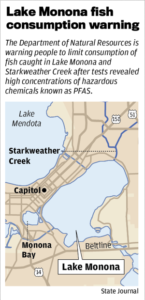DHS warns of PFAS in fish from Lake Monona, Starkweather Creek
https://madison.com/content/tncms/live/
State health officials are warning against eating certain kinds of fish from Lake Monona after tests showed hazardous chemicals known as PFAS in fish from the lake and Starkweather Creek.
The Department of Health Services recommends limiting consumption of carp, largemouth bass, walleye and perch from those water bodies to once a month. The department says it is safe to eat bluegill once a week.
The advisory includes all of Lake Monona, including Monona Bay, a popular destination for ice fishing. The Department of Natural Resources has also sampled fish from lakes Wingra and Waubesa, though test results are not expected until this spring.
Lake Monona fish consumption warning
Fish collected in June and October had PFOS concentrations of up to 110 parts per billion (110,000 parts per trillion); samples from Starkweather Creek had up to 180 ppb.
The DHS based the advisory on guidelines from the Great Lake Consortium, which recommend against eating any fish with PFOS concentrations of more than 200 ppb. The New Jersey Department of Environmental Protection this fall recommended children and all women of childbearing age not eat fish with PFOS concentrations over 17 ppb.
Two fluorinated compounds, PFOA and PFOS, have been linked to increased risks of cancer and other health problems. The chemicals do not biodegrade and can build up in the human body over time. Less is known about thousands of other fluorinated compounds that fall under the PFAS umbrella.
Madison Mayor Satya Rhodes-Conway urged people to take the advisory seriously and said the city will continue to follow “best available science” to protect public health.
Maria Powell, executive director of the Midwest Environmental Justice Organization, said the warnings don’t go far enough.
 “This blanket advisory is not protective for sensitive groups or for subsistence anglers or anyone who eats a lot of fish per meal, fries whole fish in pans or place whole fish in soups and stews,” she said. “Whole fish will have even higher levels of PFOS than fillets and they can leach into soups when cooked or into the pan when fried.”
“This blanket advisory is not protective for sensitive groups or for subsistence anglers or anyone who eats a lot of fish per meal, fries whole fish in pans or place whole fish in soups and stews,” she said. “Whole fish will have even higher levels of PFOS than fillets and they can leach into soups when cooked or into the pan when fried.”
Tony Martinson was one of several dozen anglers catching bluegill Wednesday on Monona Bay.
Martinson, 50, said he fishes a couple of times a week — “whenever work allows” — and enjoys eating bluegill. He said the news was unfortunate but wasn’t fazed by the advisory.
“Anything in the grocery store could kill you,” he said. “If anything’s going to kill me it might as well be something I could enjoy.”
Others had similar views.
Signs and meetings
The test results, released Wednesday by the Department of Natural Resources, raise questions about whether state and local officials have done enough to warn anglers about the potential dangers of eating fish from the popular fishing spot.
Officials have known for months about PFAS contamination in the creek, which drains an area surrounding the Dane County Regional Airport and Truax Field.
Water samples taken in June revealed two compounds — PFOA and PFOS — at concentrations more than 22 times the level considered safe by Michigan, one of the few states to adopt surface water standards.
Foam collected in October near the Olbrich Boat Launch had a concentration of PFOS — the compound most likely to build up in fish tissue — between 80,000 and 92,000 parts per trillion.
The Wisconsin DNR is in the process of developing surface water standards, but in Michigan PFOS concentration of more than 12 ppt is considered unsafe.
After the release of water test results in October, Public Health Madison & Dane County posted warning signs and advised people living near the creek to avoid drinking or accidentally swallowing the water or foam. Health officials also cautioned people to rinse their pets.
But they did not warn against consuming fish from the creek, saying they were awaiting the fish test results to provide “clear guidance.”
The public health department now plans to notify residents who live near Starkweather Creek and update the signs to include the consumption advisories in English, Hmong and Spanish. The department is also planning a series of public meetings later this month.
“This is a rapidly developing field,” Doug Voegeli, Dane County public health director, said in a statement. “As more data become available, we will continue to work with state partners to update any advisories and communicate those changes to the public.”
Delays perceived
Powell said state and local officials should have issued consumption warnings immediately after finding PFOS in the water, noting people who fish the creek and lake have likely been consuming the chemicals, which accumulate in the body, for years.
“There is no good excuse for delays in sharing this critical public health information so people could make choices about their fish consumption,” she said. “Scientific studies show that PFOS builds up to much higher levels in fish than in water. The levels found last summer were high enough to merit warnings immediately, as a precaution, even while waiting for the fish data.”
The DNR has not identified a source for the contamination, but firefighters from Madison and the Wisconsin Air National Guard for years trained with fluorinated foams at the Dane County Regional Airport, resulting in contaminated soils and groundwater. Recent tests showed stormwater that drains from the airport into Starkweather Creek contained high levels of PFAS.
Darsi Foss, director of the DNR’s environmental management division, said PFAS concentrations are highest just downstream from the airport.

